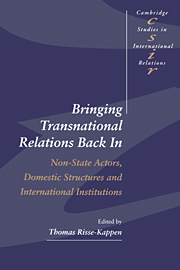 Bringing Transnational Relations Back In
Bringing Transnational Relations Back In Book contents
- Frontmatter
- Contents
- List of tables
- List of contributors
- Preface
- List of abbreviations
- Setting the agenda
- Case studies
- 2 Transnational relations and the development of European economic and monetary union
- 3 “Bullying,” “buying,” and “binding”: US–Japanese transnational relations and domestic structures
- 4 MNCs and developmentalism: domestic structure as an explanation for East Asian dynamism
- 5 Transnational relations, domestic structures, and security policy in the USSR and Russia
- 6 Mechanics of change: social movements, transnational coalitions, and the transformation processes in Eastern Europe
- 7 Ivory, conservation, and environmental transnational coalitions
- Conclusions: So what?
- Index
- CAMBRIDGE STUDIES IN INTERNATIONAL RELATIONS
5 - Transnational relations, domestic structures, and security policy in the USSR and Russia
Published online by Cambridge University Press: 02 December 2009
- Frontmatter
- Contents
- List of tables
- List of contributors
- Preface
- List of abbreviations
- Setting the agenda
- Case studies
- 2 Transnational relations and the development of European economic and monetary union
- 3 “Bullying,” “buying,” and “binding”: US–Japanese transnational relations and domestic structures
- 4 MNCs and developmentalism: domestic structure as an explanation for East Asian dynamism
- 5 Transnational relations, domestic structures, and security policy in the USSR and Russia
- 6 Mechanics of change: social movements, transnational coalitions, and the transformation processes in Eastern Europe
- 7 Ivory, conservation, and environmental transnational coalitions
- Conclusions: So what?
- Index
- CAMBRIDGE STUDIES IN INTERNATIONAL RELATIONS
Summary
We tried to create a new reality by the old methods, sending out directives from above. Well, directives, whether statutes or decrees, are accepted for implementation only by a community that is connected with the command center either by a unity of interests or by bonds of obedience and fear. When these are absent, the directive does not work.
Former Soviet Foreign Minister Eduard ShevardnadzeThis study of the effect of transnational actors on Soviet security policy addresses a country and an issue-area that were left out of the original theorizing about transnational relations in the 1970s. That literature, and the related work on interdependence, assumed that transnational relations would predominate in issue-areas outside the realm of “high politics” and in countries where democratic polities would permit penetration of government policy-making by transnational as well as domestic actors. According to this perspective, the centralized, secretive, and authoritarian regime that prevailed in the Soviet Union until the end of the 1980s was one of the least likely candidates for transnational influence. By the same token, we would expect Soviet security policy to have been the most immune to such influence.
This chapter has two main aims. The first is to present a theoretical rationale for understanding why the Soviet Union should have been open to the influence of transnational actors – in this case, organizations of Soviet and US scientists pursuing arms control initiatives – even in the high politics of security policy.
- Type
- Chapter
- Information
- Bringing Transnational Relations Back InNon-State Actors, Domestic Structures and International Institutions, pp. 146 - 188Publisher: Cambridge University PressPrint publication year: 1995
- 1
- Cited by


